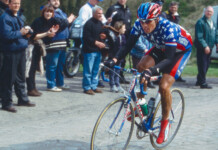The Tour de France is finally over. It has been long, hard month, and while it has been exciting, it is time to rest and recoup. For me, that is. I suppose the riders may be tired, too, but they don’t have it nearly as tough as I do, a Tour fanatic. They at least have a good night’s rest after a regular work day.
Meanwhile, I go to work during the day, then come home and, after doing only the essential household and other duties, sit down at the TV for several hours to watch the stage recorded earlier that day. Throughout my work day, I have to make a concerted effort to avoid any news about that day’s stage, and warn friends against spoiler alerts. Then, after staying up till midnight or later to watch the coverage, I have to arise with a couple of hours less than my usual sleep to take on the next day. And that is in addition to all the other normal and usual things I have to do throughout the month of July. It makes for a hard month.
So why do I do it? Simple. It is the most exciting sporting event around. Sure, as a cyclist, I am biased. But the Tour is about much more than who wins. The Tour is a sporting event with so much happening on so many different levels. And you get to experience it for nearly the entire month of July.
This year’s Tour exemplifies the complex nature of the Tour with its many subplots, and it was especially exciting. In typical fashion, the first week was comprised primarily of flat stages that showcased the sports sprinters’ and short-burst finishers. Who would dominate? With Marcel Kittel absent due to injuries, would Mark Cavendish reign as the sprint king? Would André Greipel overcome Cavendish’s dominance? Would crowd favorite Peter Sagan end his nearly two year drought of Tour stage wins?
No, yes and no. Indeed, during the first week, Greipel won two sprint finishes in Stages 2 and 5, would go on to win another sprint finish in Stage 15, and cap that off with a great sprint victory the final day on the Champs-Elysées.. With 4 sprint victories, the last one being the jewel win on the Champs-Elysées, Greipel became this year’s sprint king.
Sagan, meanwhile, would have 5 second place finishes but no wins. Still, he kept life exciting in several of what might otherwise have been mundane stages by getting in the breakaways. There, however, he would often be stymied when everyone else in the breakaway was riding against him. Though his efforts still left him short of victories, they did result in his fourth consecutive green jersey (sprint points competition). By capturing most of the intermediate sprints as a result of being in these breaks, and by placing high in others and the sprint finishes, Sagan outdistanced Greipel in the battle for the green jersey despite Greipel’s fantastic Tour performance.
Meanwhile, though Cavendish did win Stage 7, he fell short of his and most everyone else’s expectations. But he gives credit where credit is due, to Greipel for instance, and never makes excuses for his performances. For this and other reasons, he is also a crowd favorite, and we all were on edge and then disappointed as the sprint victories eluded him.
Then there was the question of who the winners of each of the individual stages would be. Each stage is a separate race, and each is exciting. Of the 20 individual stage wins available (one was a team time trial won by BMC), there were 16 different winners. In many of these, the winner was the final survivor of a breakaway group. These were all exciting, but the breakaway wins by Romain Bardet, Joaquim Rodriguez, Reuben Perez, Tony Martin, Simon Geschke and Thibaud Pinot had me particularly on edge as I tensed to see if they could hold out till the finish. While pulling for many of these breakaways, I was admittedly hoping Sagan would catch Perez, American Andrew Talansky would catch Geschke, and Quintana would catch Pinot. But I, with everyone else, could not help but be moved when Geschke, a veteran with no major victory before in his career, could only weep as he tried to answer journalists’ questions. This was great stuff.
There are also the unexpected stories that inevitably arise from a month long stage race. For Daniel Teklehaimanot, his Tour participation alone was a dream come true. Hailing from Eritrea in Africa, there were some political machinations that nearly prevented him from participation due to his country’s record on alleged human rights violations. And that was only after his team, MTN-Qhubeka, received a somewhat surprising invitation to even participate in the Tour. To top it off, he managed to snag enough early mountain points to earn and wear the polka dot jersey for a few days as the best-ranked climber. This was a moment he had dreamed of since he was a kid.
Then, of course, there are the tragedies and disappointments. For us Americans, there was the sudden collapse of Tejay Van Garderen on Stage 16 that result is his withdrawal from the race while sitting third overall. He had been looking very strong, and this turn of events was odd and left me, for one, scratching my head.
There are many such stories, both exhilarating and disappointing, during the Tour, and it is a true reality show to watch these stories unfold day to day as riders battle for stage wins, the green jersey, the polka dot jersey, the white jersey (best young rider) and the yellow jersey. With nearly every stage comes such a story.
But let’s be honest: In the end, the Tour is about the yellow jersey. But not just who will have it when arriving in Paris. There is also the battle to see who can snag it for a day or two or more along the way. It started out per tradition with Vincenzo Nibali as last year’s winner, but was taken by BMC’s Rohan Dennis who won the opening individual time trial with a surprising victory over the favorite, Tony Martin. The next day, it crossed over to that well-known veteran, Fabian Cancellara as a result of being better placed than Dennis at the end of a wind-swept stage that split the peloton apart.
Cancellara would wear the yellow jersey only one day before withdrawing from the Tour prior to the start of Stage 4 as a result of fractured vertebrae received in a spectacular crash (repeatedly replayed the remainder of the Tour) during the previous day’s Stage 3. Who can forget the image of Cancellara’s yellow bike flying through the air? Meanwhile, Froome donned the yellow jersey, only to lose it to Tony Martin following his breakaway victory in the final kilometers of Stage 4’s journey across the cobbles of northern France. This was an especially poignant moment for Tony Martin who, despite his illustrious career, had never worn the yellow jersey. This was made all the more spectacular by the fact that, just prior to his bold attack to win the stage and take the yellow jersey, he had flatted, been given a bike by his teammate, regained the lead group, and then initiated his bold attack.
Martin would then wear the yellow jersey for two days before losing it, as Cancellara had, as a result of a crash which he unwittingly caused in Stage 6 and in which he suffered a Tour ending broken collarbone. Out of respect to Martin, Froome, who was again atop the standings as a result of Martin’s withdrawal, stated he would not don the yellow jersey the next day.
At that point, the yellow jersey came back to Froome, and his challenge was to make certain it was his when the Tour would end in Paris. This would be, as it turned out, no easy task. He never surrendered it again, but that was from no lack of effort on the part of the other contenders.
Four men came to the Tour as pre-race favorites: Chris Froome, Alberto Contador, Nairo Quintana and last year’s victor, Vincenzo Nibali. They, along with several other less likely winners including Alejandro Valverde and our own Tejay Van Garderen, all came to the Tour in good health and with high expectations. It was the strongest group of challengers in years, with no serious contender missing.
Froome put his stamp on the Tour early, with a magnificent performance in Stage 10 where he crushed his opponents with a statement making victory on the mountain finish in La Pierre Saint Martin. He left all his challengers sucking wind and reeling with a victory that cost those challengers not seconds but minutes. It seemed, from all appearances, that it was now his Tour to lose.
Which in fact was true, but that did not prevent the others from trying. Froome and his Team Sky teammates had to deal with attack after attack on nearly each and every subsequent mountain stage. Nibali would go, only to be chased down by Team Sky. Then it would be Contador. Following his capture, Quintana or his teammate, Valverde, would attack. Or some variation of the above. To their credit, they all continued to try to dislodge Froome and Team Sky.
At first, it appeared Froome and his team could handle it all. But in the last week, it was clear they were beginning to fray. Finally, on Stage 19, Quintana managed to drop Froome and gain back 30 seconds of his 3:08 deficit. With Froome and Sky’s weakening status now apparent, the stage was set for a huge battle on the penultimate stage, and final mountain stage, that would end with the legendary climb up l’Alpe d’Huez. Froome and his team were clearly “on the rivet”, and Quintana, Valverde and their Movistar team were ready to try to pull off a near impossible upset.
This stage turned out to be everything the organizers, fans and spectators could hope for. Valverde and Quintana put in their attacks, both on the Col de la Croix de Fer and on l’Alpe d’Huez. It was exciting, with the finish uncertain till the last couple of kilometers on the stage. Quintana gained 1:20 on Froome, but Froome hung on to the last 1:12 of his lead to cling to the yellow jersey and insure his overall victory.
All this and much more is what makes the Tour de France the unique and spectacular sporting event that it is. Many stories, many layers and many subplots. Victory and tragedy, exultation and dejection, great performances and disappointments. This was a great Tour. Worth every minute I stayed awake to follow it.
But I’m glad it’s over, because I can’t keep that pace up.








